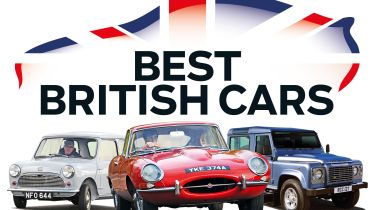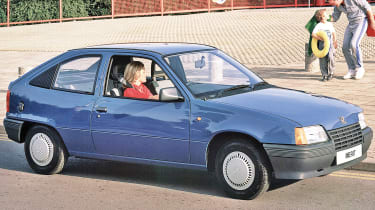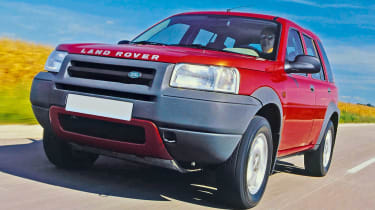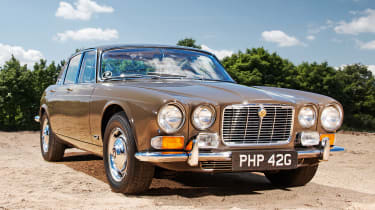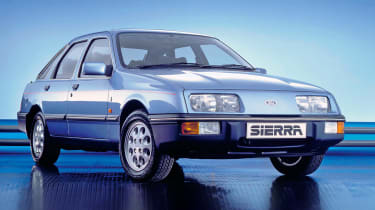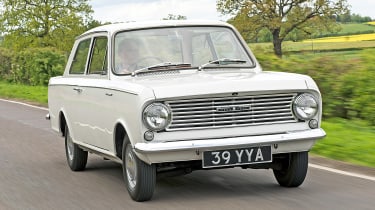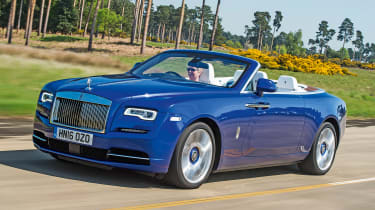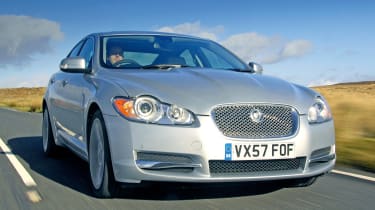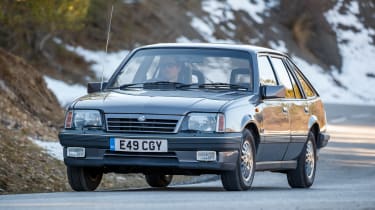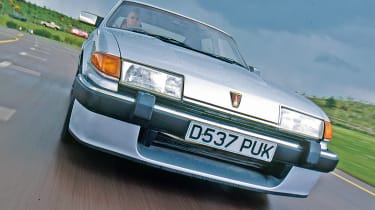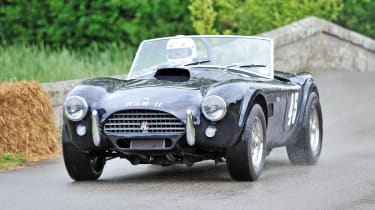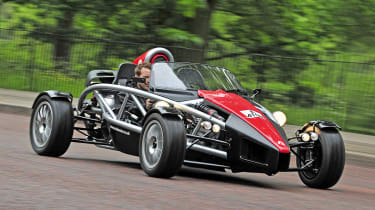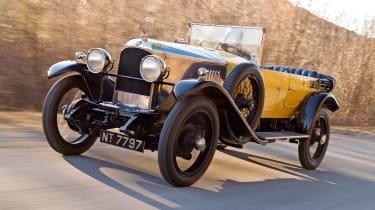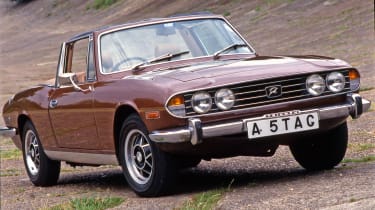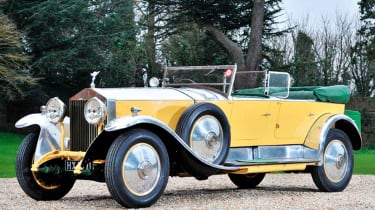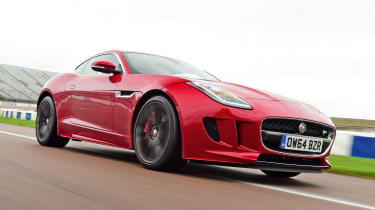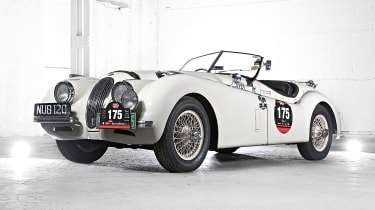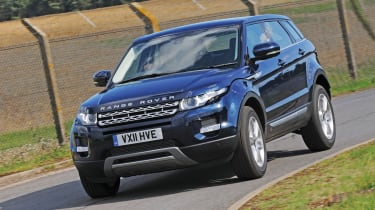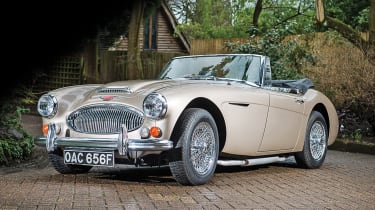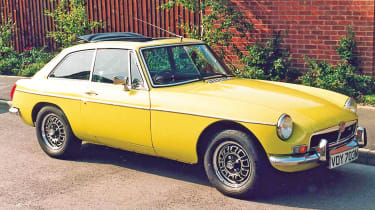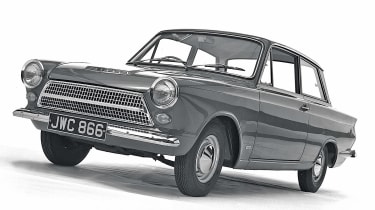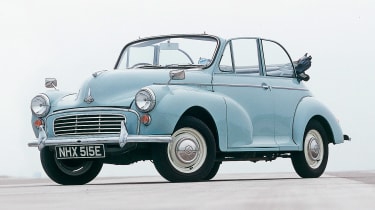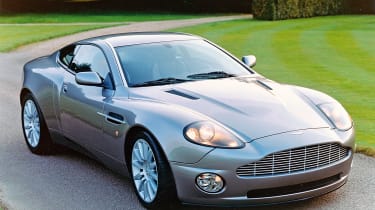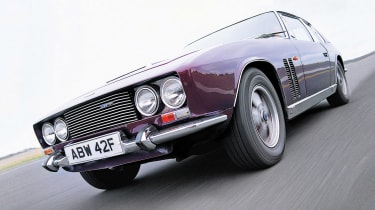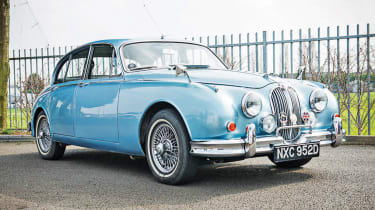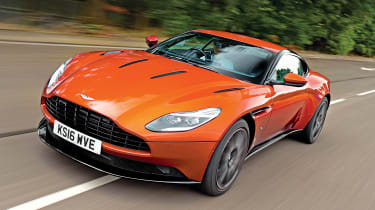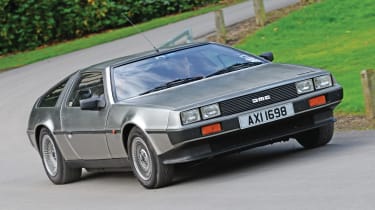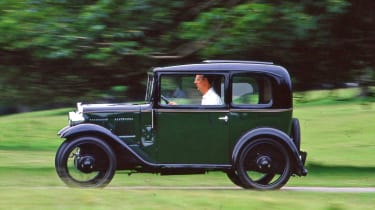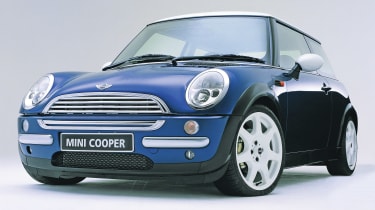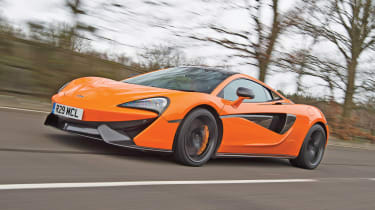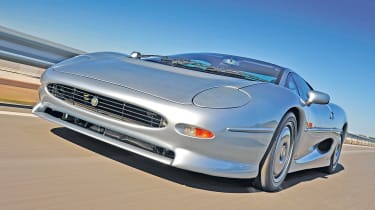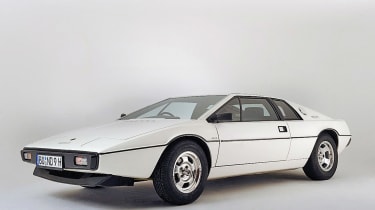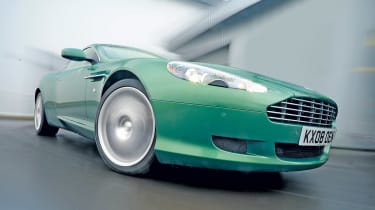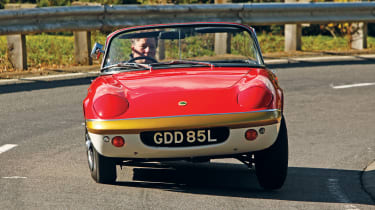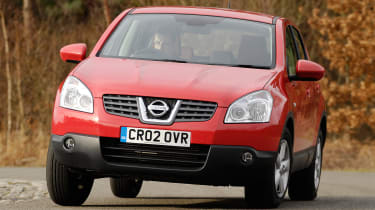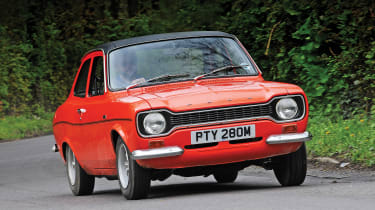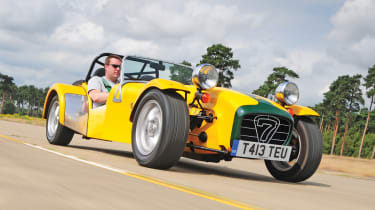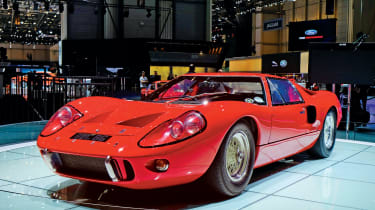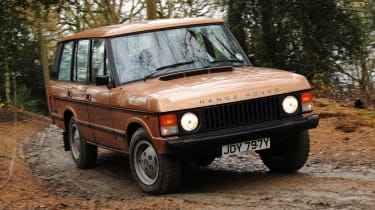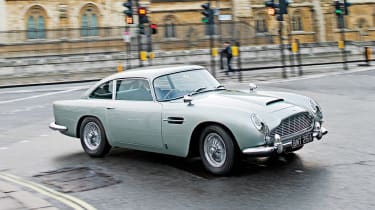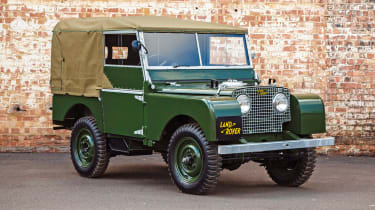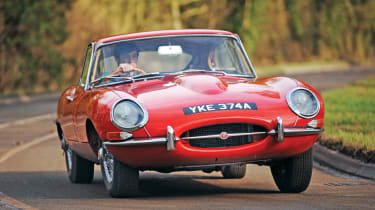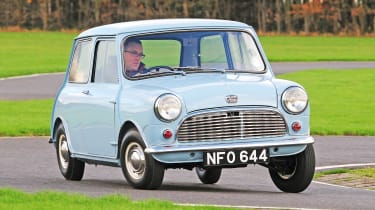Best British cars: Top 50 all-time greatest British-built cars revealed
The British car industry has had its highs and lows but what are the best cars ever built in Britain? We pick our top 50!
From the original Mini to the best offerings from the likes of Jaguar, Aston Martin, Rolls-Royce and McLaren, the small island of Great Britain has punched well above its weight by producing some incredible motors in its time. But what is the best British car?
In an attempt to answer the question, Auto Express set itself the unenviable task of naming the best British-built car of all-time, taking into account sales success, groundbreaking design and unbeatable performance. For a task this big, however, we couldn’t do it alone. That’s why we enlisted the help of some industry big-hitters who’ve recently graced our own Brit List. Of course, our own team of experts who’ve driven and tested some of these special motors in their time also had their say.
So, scroll down to see our countdown of the top 50 cars ever to roll off factory production lines in Great Britain...
The best British cars top 50
50. Triumph Herald
- Years of manufacture: 1959-1971
- Price when new: £708
- Price now: £500-£10,000
- Engine: 1,147cc 4cyl petrol, 48bhp
- Top speed: 80mph
For an entire generation of drivers, the Triumph Herald will forever hold a special place in their hearts as the car in which they learned to drive. Throughout its 12-year run, it was the first choice for driving schools due to its great visibility and easy-to-use controls, plus its party trick – a 7.6m turning circle that made test manoeuvres a breeze.
Once a licence was obtained, the Herald still made sense as a family car. It was cheap to run and maintain, yet had the look of a miniature American automobile with fins and hooded headlamps. The interior was marginally more luxurious than rivals’, too.
49. Vauxhall Astra Mk2
- Years of manufacture: 1984-1991
- Price when new: £7,971
- Price now: £200-£12,000
- Engine: 1,598cc 4cyl petrol, 81bhp
- Top speed: 111mph
Ford’s Escort was looking old by the time the Astra Mk2 was introduced in late 1984, giving Vauxhall a real chance to catch its rival. The Astra was good enough to win the European Car of the Year award in 1985, and had an aerodynamic body that looked modern and saved on fuel, too. The model’s case was helped when the Mk4 Escort was launched to a lukewarm reception. To keep up with Ford, Vauxhall offered myriad bodystyles: hatchbacks, vans, estates, convertibles and even a saloon called the Belmont.
Despite all this, the Astra never quite caught the Escort in the sales charts – but it got close enough to convince the blue oval that it needed to make more of an effort.
Judge’s verdict: “Three-door, five-door, estate, convertible, van and saloon – the Mk2 Astra had all the bases covered. A 1989 BTCC title for John Cleland in a GTE provided some performance glamour, too.” - Stuart Milne, Editor, CarBuyer
48. TVR Chimaera
- Years of manufacture: 1992-2003
- Price when new: £26,720
- Price now: £10,000-£20,000
- Engine: 3,950cc 8cyl petrol, 275bhp
- Top speed: 158mph
As tastes and legislation changed, traditional big-engined British sports cars had withered away to virtual extinction by the nineties. The notable exception was TVR. The Blackpool manufacturer bucked the trend for blander, safer cars as it made outrageously styled roadsters complete with meaty V8s.
The Chimaera was developed as a more practical GT version of the Griffith, with softened driving dynamics and a more usable boot. It retained the same Rover-derived V8, soft-top arrangement and questionable build quality. It became something of a surprise hit, too – in its 10- year production run more than 6,000 were produced, making it the company’s biggest success.
47. Land Rover Freelander
- Years of manufacture: 1997-2015
- Price when new: £15,995
- Price now: £500-£30,000
- Engine: 1,796cc 4cyl petrol, 118bhp
- Top speed: 102mph
When BMW acquired Rover, the new bosses were given a tour to see what they’d bought. One of them spotted models of a compact SUV which had been created nearly a decade before.
Rover didn’t have the money to develop it, so the project stalled. BMW immediately saw the potential and ordered that work be restarted. Three years later, the Freelander arrived. A range of bodystyles and engines covered all the market and it was a huge hit. It stemmed the flow of Japanese rivals with better brand image and surprisingly good off-road ability. The second generation took the brand further upmarket and improved reliability.
46. Jaguar XJ6 Mk1
- Years of manufacture: 1968-1973
- Price when new: £1,797
- Price now: £2,000-£30,000
- Engine: 2,792cc 6cyl petrol, 180bhp
- Top speed: 120mph
“The best car in the world” is a boast that Rolls-Royce would hope to own. But in 1968 the title belonged to the Jaguar XJ, a model line that has survived unbroken until today. With graceful styling, interior luxury, excellent refinement and effortless performance, the first XJ was the choice of celebrities, VIPs and successful executives alike. The V12 version added 140mph performance, too, although it certainly needed both of its distinctive twin fuel tanks to feed its engine.
The Mk2 came along in 1973 with arguably better looks, but it was then built by British Leyland and the quality suffered. As a result, the Mk1 is regarded by some as Jaguar’s finest-ever saloon.
45. Ford Sierra
- Years of manufacture: 1982-1993
- Price when new: £6,615
- Price now: £300-£60,000
- Engine: 1,769cc 4cyl petrol, 90bhp
- Top speed: 106mph
Although it eventually became a common sight, the Sierra caused a seismic shock upon its 1982 launch. Rather than evolve the best-selling Cortina, Ford changed the shape to something far more radical – and the public wasn’t quite ready. The Sierra was nicknamed “the jellymould”, and sales were slow at first.
Yet with familiarity the Sierra became a success and started to make its rivals look old-fashioned – even though the car still had a very conventional powertrain. The image boost was helped by the legendary RS Cosworth, which became famous for its racetrack success and infamous for its magnetism to joyriding thieves.
Judge’s verdict: “The most extraordinary thing about the Sierra has to be the RS Cosworth. It was a true race car for the road, and remains one of the ultimate eighties icons.” - Steve Fowler, Editor-in-chief, Auto Express
44. Vauxhall Viva
- Years of manufacture: 1963-1966
- Price when new: £539
- Price now: £500-£6,000
- Engine: 1,057cc 4cyl petrol, 44bhp
- Top speed: 80mph
Vauxhall watched in envy during the sixties as Morris and Ford chalked up thousands of sales with their Minor and Anglia respectively. The solution was the 1963 Viva HA, a conventional-looking saloon that was exceptionally easy to drive, with light controls and good visibility. These attributes made it popular with new drivers and women – a fact Vauxhall made the most of in its advertising.
Despite being a huge success, the HA was replaced by the Viva HB after only three years. The Bedford van version of the HA lasted rather longer; huge fleet deals with British Telecom and the Royal Mail kept it in production until 1983.
43. Rolls-Royce Dawn
- Years of manufacture: 2015-2022
- Price when new: £265,155
- Price now: £265,175
- Engine: 6,592cc 12cyl petrol, 563bhp
- Top speed: 155mph
Although most of us will never be able to afford any sort of Rolls-Royce, it’s easy to think that the £265,000 Dawn was merely a Rolls for buyers who weren't quite rich enough to afford the £365,000 Phantom drophead.
However, the reality is a little different. The Dawn is more compact and more engaging from behind the wheel than the Phantom – a model that in turn has always been described by Rolls-Royce itself as a “yacht for the road”. The luxury British manufacturer hoped that the less ostentatious Dawn would appeal to a much younger audience, who might otherwise have been tempted to buy a Continental GT from old rival Bentley.
42. Jaguar XF
- Years of manufacture: 2007-present
- Price when new: £33,900
- Price now: £32,490
- Engine: 1,999cc 4cyl diesel, 163bhp
- Top speed: 132mph
Under Ford’s ownership, Jaguar launched the S-Type. A rival to the BMW 5 Series, it harked back to the glory days when Jaguars were the most beautiful cars on the road. The trouble was it missed the mark and wasn’t terribly attractive.
Jaguar designer Ian Callum changed all that when it came to replace the S. Instead of creating a bad pastiche of an old car, he styled something that was seen as being as bold and well proportioned in 2007 as the Mk2 was in 1959. A smart estate, efficient diesels and a neat facelift have helped the XF become a car that would actually be tempting for a BMW owner.
41. Jaguar F-Pace
- Years of manufacture: 2015-present
- Price when new: £34,170
- Price now: £34,730
- Engine: 1,999cc 4cyl diesel, 163bhp
- Top speed: 121mph
The idea of a Jaguar SUV would have seemed crazy only a decade ago. The brand was famous for sleek sports cars and saloons, not clunky mud-pluggers. But times change. Bosses looked on in envy as BMW, Mercedes and Audi swept up buyers with a range of family friendly ‘lifestyle’ 4x4s such as the X5 and ML – so it grabbed a piece of the action, in some style.
The F-Pace combined the great dynamics of the saloons with the style of the sports car. It’s not meant to be a hardcore off-roader, but Land Rover helped with the 4x4 system, too. It was good enough to be our Car of the Year in 2016.
40. Vauxhall Cavalier Mk2
- Years of manufacture: 1981-1988
- Price when new: £6,588
- Price now: £500-£5,000
- Engine: 1,598cc 4cyl petrol, 90bhp
- Top speed: 105mph
In the early eighties, the company car market accounted for a massive chunk of British car purchases. Salesmen and middle managers plied their trade by travelling on the motorways of Britain, mainly in Cortinas. However, the Ford was getting old, the Austin Princess was staid and the Maxi was too weird.
Against these rivals Vauxhall introduced the attractive, front-wheel-drive Cavalier. It offered class-leading economy to keep the expense claims low, and was faster than rivals, too. When Ford launched its radical Sierra in 1982, the market took time to adjust, giving Vauxhall even more time to gain a foothold. The two marques have fought for supremacy in the sector ever since.
39. Rover SD1
- Years of manufacture: 1976-1986
- Price when new: £4,750
- Price now: £1,000-£10,000
- Engine: 2,597cc 6cyl petrol, 136bhp
- Top speed: 119mph
Rover tends to be remembered these days as a manufacturer of staid cars, but back in the sixties and seventies its designs were really cutting-edge. The SD1 (it was the first car from a Special Division) looked like a Ferrari Daytona, had an innovation called a ‘hatchback’ and used new production techniques. It was even impressive enough to win the European Car of the Year title in 1977.
However, the curse of British Leyland struck again. Models that made it through the strikes fell apart and had to be rebuilt and repainted by dealers. Amazingly, buyers stuck with it, and the car evolved into a respected exec – especially in muscular V8 Vitesse form.
38. AC Ace/Cobra
- Years of manufacture: 1953-1967
- Price when new: £2,453
- Price now: £400,000-plus
- Engine: 4,727cc 8cyl petrol, 271bhp
- Top speed: 140mph
AC had been quietly making cars at its facility to the south of London ever since 1901, including in the fifties a pretty roadster called the Ace. The two-seater then got the attention of a retired American racing driver called Carroll Shelby, who had a dream of making a supercar that could beat the Chevrolet Corvette and even the mighty Ferrari on track.
So Shelby bolted a Ford V8 engine on to the Ace chassis and renamed the car the Cobra. It was pretty and exceptionally fast, both on and off the circuit. It’s since been copied by countless replica and kit car companies. The Cobra was also blamed for the imposition of the motorway speed limit in Britain, after a test driver was clocked at 185mph on the M1 in a race-tuned coupe.
37. Bentley Continental GT
- Years of manufacture: 2003-present
- Price when new: £110,000
- Price now: £141,240
- Engine: 5,998cc 12cyl petrol, 552bhp
- Top speed: 198mph
After a stressful divorce from Rolls-Royce in 1998, Bentley was free to make its own cars rather than merely rebadging Rollers. To help, it had the money and expertise of new owner the Volkswagen Group. The Continental GT was revealed to an eager world in 2003, and in some ways it was controversial.
The coupe shared major parts with VW’s Phaeton luxury saloon, and the Crewe factory used some mass-production techniques rather than previous Bentleys’ hand-built craftsmanship. Yet the GT was half the cost of what went before, and faster, more comfortable and better to drive. It hugely boosted sales worldwide.
36. Ariel Atom
- Years of manufacture: 2000-present
- Price when new: £19,995
- Price now: £30,572
- Engine: 1,998cc 4cyl petrol, 245bhp
- Top speed: 140mph
Setting up as a brand new sports car manufacturer in Britain is often seen as a highly efficient way to turn a large fortune into a small one; the list of failed companies is tragically long. However, Ariel has proven to be an exception.
Developed from a university project, the Atom is basically a single-seat racer with an extra seat and the bare minimum to make it road legal. It weighs 620kg, has a Lotus-engineered chassis and power is from a choice of reliable Honda units. If that didn’t offer enough thrills, Ariel got an even better reception when it bolted in a 500bhp V8 and gave the pylon-on-wheels a 2.3 second 0-60mph time.
Judge’s verdict: “It’s not to all tastes, but the Atom demonstrates the breadth of talent in the UK automotive industry. It really is a car unlike anything else.” - Steve Walker, Website editor, Auto Express
35. Vauxhall 30/98
- Years of manufacture: 1913-1927
- Price when new: £1,350
- Price now: £400,000-plus
- Engine: 4,244cc 4cyl petrol, 115bhp
- Top speed: 100mph
The pre-war Vauxhall 30/98 might look like Chitty Chitty Bang Bang, but in its day it was one of the ultimate supercars. The 30/90 Velox was produced to satisfy a racer who complained that no car could maintain 100mph at Brooklands race circuit.
Vauxhall came up with a new 115bhp, 4.2-litre four-cylinder that it proved could – unlike contemporary Bentleys and other exotica. The car was relatively luxurious, too, with innovations such as electric lights and a starter motor. About 600 30/98s were built from 1913-’27; a third are thought to survive today.
34. Triumph Stag
- Years of manufacture: 1970-1977
- Price when new: £2,093
- Price now: £1,500-£25,000
- Engine: 2,997cc 8cyl petrol, 146bhp
- Top speed: 115mph
With a range of successful sports saloons and roadsters to its name, Triumph was in a good position to launch an upmarket four-seater luxury convertible. The Stag had Italian styling, hard and soft-tops, plenty of gadgets and a newly designed V8 under the bonnet. On paper it was more than a match for rivals such as the Mercedes SL – but the theory didn’t take into account the poor engineering, shoddy production and industrial disputes that plagued the British motor industry in the seventies.
The complex V8 engine constantly broke, usually in a terminal manner, and the car became virtually unsellable. As a result, only 25,877 examples were produced before the Stag was finally put down in 1977. Despite all of this, it is a collectors’ car today.
Judge’s verdict: “With svelte styling, a T-shaped roll-over bar and seating for four, the Stag had the right ingredients to be a success. It was just a shame BL chose the wrong engine for it.” - Lawrence Allan, Staff writer, Auto Express
33. Rolls-Royce Silver Ghost
- Years of manufacture: 1906-1926
- Price when new: £998
- Price now: £10million-plus
- Engine: 7,036cc 6cyl petrol, 48bhp
- Top speed: 60mph
Rolls-Royce launched a car called the 40/50hp in 1906. A year later, a model was built for marketing purposes and called ‘Silver Ghost’ because of its silver paint and spooky quietness. The car was exquisitely engineered – and to prove this, it was used successfully in reliability trials, which included driving between London and Glasgow 27 times. The task would be gruelling in a modern motor on today’s roads, let alone back then.
As a result the Silver Ghost became famous, and Rolls-Royce began to apply the name to all of its 40/50hp models. The original Silver Ghost, wearing the registration plate AX201, is now thought to be one of the most valuable cars in the world.
32. Jaguar F-Type
- Years of manufacture: 2013-2023
- Price when new: £51,235
- Price now: £51,455
- Engine: 2,995cc 6cyl petrol, 337bhp
- Top speed: 161mph
Ever since the portly XJ-S replaced the E-Type, enthusiasts had been calling for Jaguar to make an F-Type. It should be a lithe sports car with good looks and great handling, they said, capable of exciting the same passions as the E-Type did upon its launch. A concept model got close to production back in 1982, but never quite made it. Then, in 2013, the enthusiasts finally got their wish.
The new F-Type was small, fast and great to drive. Its styling nodded to the classic E but was also bang up to date. A coupe arrived a year later and arguably looked even better. It’s a car worthy of the name.
31. Jaguar XK120
- Years of manufacture: 1948-1954
- Price when new: £1,263
- Price now: £60,000-£120,000
- Engine: 3,442cc 6cyl petrol, 160bhp
- Top speed: 120mph
In 1948, Jaguar wanted to test and publicise its brand new engine. It took a Mk5 saloon chassis and added a sleek roadster body, then put the car on its London Motor Show stand, and watched as eager customers waved chequebooks at its sales staff. The first customer in line was film star Clark Gable.
The XK120’s number denoted the top speed; it was the world’s fastest production car. The first versions were wood framed with aluminium panels, but by 1950 Jaguar realised it couldn’t keep up with demand so switched to more conventional steel construction. The car was replaced in 1954 by the equally pretty XK140.
30. Range Rover Evoque Mk1
- Years of manufacture: 2011-2018
- Price when new: £27,995
- Price now: £30,760
- Engine: 1,999cc 4cyl diesel, 148bhp
- Top speed: 113mph
In an idle moment, Jaguar stylist Julian Thompson doodled a car for sister brand Land Rover. It was a compact, premium SUV that looked incredibly futuristic and had certain lines that linked to one of his earlier designs – the Lotus Elise.
Bosses liked the look of it and developed it into the 2008 LRX concept. The reaction persuaded them to put it into production – complete with a posh interior and the Range Rover badge to justify its inflated price. By launch in September 2011, Land Rover had 18,000 deposits for the car they named Evoque. A year later, the company had sold a huge 80,000 and there was a lengthy waiting list.
29. Austin Healey 3000
- Years of manufacture: 1959-1968
- Price when new: £1,257
- Price now: £20,000-£70,000
- Engine: 2,912cc 6cyl petrol, 124bhp
- Top speed: 113mph
In the late fifties, sports cars were big business. It wasn’t only in this country where they were popular, either; in that era, American buyers were lapping up British-built roadsters and providing us with vital export dollars.
The ‘big Healey’ was introduced in 1959, and used a body built by Jensen and a 3.0-litre straight-six powerplant borrowed from some staid saloons.
It looked gorgeous – except during wet weather, when the very basic rain protection had to be used. However, most Americans don’t get nearly as much rain as we do here in the UK, and as a consequence more than 85 per cent of all Austin-Healey 3000 cars were exported across the Atlantic.
Judge’s verdict: “Arguably the original hairy-chested British sports car, the 3000 started out as a rakish and swift brute. Over the years it became more refined and powerful.” - Tom Barnard, Creative director, Auto Express
28. MGB
- Years of manufacture: 1962-1980
- Price when new: £849
- Price now: £1,000-£30,000
- Engine: 1,798cc 4cyl petrol, 95bhp
- Top speed: 105mph
Peer behind the garage doors of an average suburban housing estate back in the sixties and seventies, and it wouldn’t be long before you found an MGB. The two-seat roadster (or coupe) is now the archetypal classic car, and with good reason. It’s great looking, fun to drive and simple enough for the DIY mechanic to maintain at home. It helps that parts are easy and cheap to find, too.
At its launch in 1962 the MGB was quite an innovative design, as it used a monocoque construction instead of the then-traditional separate-chassis set-up. It proved popular in the vital American market, too. This all helped the car have a long life, and it survived in production until 1980.
27. Land Rover Discovery Mk1
- Years of manufacture: 1989-1998
- Price when new: £19,249
- Price now: £200-£10,000
- Engine: 2,496cc 4cyl diesel, 110bhp
- Top speed: 87mph
While early Discoverys are only just emerging from ‘banger’ territory, the model is now being appreciated for the innovative, landmark car it was. Launched in 1989, it plugged a chasm in the Land Rover range between the utilitarian Defender and upmarket Range Rover. It also went one better than Japanese rivals, being family friendly, spacious, practical and stylish.
The light and airy cabin was the work of Conran consultants, and there was even a seven-seat option. But perhaps the Discovery’s biggest achievement was how it was put into production on a comparative shoestring. From these humble beginnings came a great car that may well have saved Land Rover.
26. Ford Cortina Mk1
- Years of manufacture: 1962-1966
- Price when new: £643
- Price now: £500-£55,000
- Engine: 1,498cc 4cyl petrol, 60bhp
- Top speed: 82mph
In the early sixties, car makers across Europe were experimenting with all sorts of innovative technology. But Ford shunned it all for its new car, using tried-and-trusted mechanicals that were cheap to produce and maintain.
Private and company motorists alike loved the Cortina – or Consul Cortina, as it was named at its launch in 1962. It was easy to drive, comfortable and just the right size for a family. A twin-cam Lotus version became a legend on the track, too, and helped give the car a sexier image. It paved the way for the later Cortinas to become Britain’s best-seller from 1972-81.
25. Morris Minor
- Years of manufacture: 1948-1971
- Price when new: £628
- Price now: £400-£20,000
- Engine: 948cc 4cyl petrol, 37bhp
- Top speed: 62mph
At the end of World War Two, Morris needed a new affordable car to appeal to the UK and export markets. It brought in hot-shot engineer Alec Issigonis – who also designed the Mini.
He conceived a car that would make the owner proud and was also as big inside as larger, more expensive models. The Morris Minor was finally revealed in 1948, and it became
an instant hit. It was made available in two-door, four-door, convertible, estate, van and pick-up bodystyles, and it became the first British car to sell a million examples. Now it’s one of the most popular classics in Britain, too.
Judge’s verdict: “The Minor is another lesson in car design from Alec Issigonis. Some forget he was even responsible for the car, because the Mini stole the show, but its ingenuity and flexibility will forever make it a classic.” - Sam Naylor, Staff writer, Auto Express
24. Aston Martin Vanquish
- Years of manufacture: 2001-2007
- Price when new: £164,349
- Price now: £80,000-£120,000
- Engine: 5,935cc 12cyl petrol, 450bhp
- Top speed: 200mph+
After the brutish and slightly crude Virage, the 2001 Vanquish was a revelation. It previewed the VH chassis used in the DB9, making extensive use of bonded aluminium and composite. The sleek looks were the work of Ian Callum, who now pens Jaguars. With comparatively light weight, smooth aerodynamics and a 450bhp V12, the Vanquish became the first production Aston to top 200mph.
The only blot on its copybook was an underdeveloped clutchless transmission; most cars have now been converted with conventional boxes. The chassis glue wasn’t the only successful ‘bond’ – the Vanquish was 007’s car in Die Another Day.
23. Jensen Interceptor FF
- Years of manufacture: 1966-71
- Price when new: £5,249
- Price now: £80,000-£100,000
- Engine: 6,276cc 8cyl petrol, 330bhp
- Top speed: 140mph
While the Interceptor is considered a classic in its own right, the huge-engined grand tourer didn’t really push the boundaries of innovation – until the FF came along in 1966. The Ferguson Formula was packed with technology that still seems advanced today.
It was the first performance car with four-wheel drive, beating the more famous Audi Quattro by 14 years. It was the first with anti-lock brakes too, using a system that had been developed for aircraft. Sadly it wasn’t a commercial success, due to the huge list price as well as the right-hand-drive-only format, which ruled out export sales.
22. Jaguar Mk2
- Years of manufacture: 1959-1967
- Price when new: £1,843
- Price now: £10,000-£70,000
- Engine: 3,781cc 6cyl petrol, 200bhp
- Top speed: 125mph
Few things are equally loved by both bank robbers and policemen, but the Jaguar Mk2 is an exception. Launched in 1959, it was the epitome of the “Grace, space and pace” that marque founder Sir William Lyons said should define a Jaguar. Gorgeous bodywork, a smart wood and leather interior plus engine choices including a 200bhp 3.8-litre straight-six meant that the Mk2 could hit 125mph with five people on board. That made it the first choice as a getaway car – and for the police who were chasing the crooks.
Modern-day Jaguar Mk2 fans are more likely to know the classic saloon model as the car that was driven by an on-screen policeman – Inspector Morse.
21. Aston Martin DB11
- Years of manufacture: 2016-2023
- Price when new: £154,900
- Price now: £154,900
- Engine: 5,204cc 12cyl petrol, 608bhp
- Top speed: 200mph
When you only launch a fresh car every 12 years, you’ve got to ensure any new model is sophisticated enough to be desirable for more than a decade. That’s not easy for anyone, let alone a manufacturing minnow such as Aston.
The formula the company used for the DB11 was to borrow technology and powertrains from Mercedes and recruit a forward-looking executive from Nissan. The model was the company’s first product to be launched under the new regime, and it’s a world-beater. Fast, refined and beautiful to look at, the 200mph V12 coupe smashed Aston Martin sales records, and made the company’s future look secure once more.
20. Delorean DMC12
- Years of manufacture: 1981-1983
- Price when new: £16,660
- Price now: £20,000-£40,000
- Engine: 2,849cc 6cyl petrol, 130bhp
- Top speed: 130mph
The DMC12 was supposed to be a futuristic car packed with innovation, and John DeLorean convinced investors – including the British Government – to part with millions to get the project off the ground. Lotus did much of the development work, and a new factory was built in Belfast. However, the stainless steel, gullwinged car was plagued with problems at its launch in 1981 – not least that it was slow and unreliable. As the company plunged into debt, DeLorean grasped at a final straw; he was caught trying to smuggle cocaine to finance the business.
The DMC12’s renaissance came on the screen – it’ll be forever remembered as the time-travelling car in Back To The Future.
19. Austin Seven
- Years of manufacture: 1922-1939
- Price when new: £135
- Price now: £5,000-£25,000
- Engine: 747cc 4cyl petrol, 10.5bhp
- Top speed: 53mph
Long before the Mini came another tiny British car that was an engineering marvel and international success. The Austin Seven was conceived in the early twenties as a ‘proper car in miniature’ to supplant the motorcycle and sidecar combinations that were the choice of a whole generation of impecunious road users.
The model was a huge success, and was copied and modified all over the world. Production lasted from 1922 until 1939, and other automotive brands including Jaguar, Lotus, BMW and Datsun all began making derivatives of the Seven.
18. MINI Hatch Mk1
- Years of manufacture: 2000-2006
- Price when new: £12,396
- Price now: £500-£29,990
- Engine: 1,598cc 4cyl petrol, 115bhp
- Top speed: 124mph
How do you follow an act such the original Mini? The answer was the capital-lettered MINI; a car that was bang up-to-date and yet retained all the original’s fun and character – if not the innovation.
Under the watchful eye of owner BMW, Rover engineers created the all-new model to be a ‘premium’ small car, far away from the original’s budget beginnings. But it was still reasonably compact and – crucially – was great to look at, with smile-inducing driving dynamics. Clever marketing and infinite personalisation options made it a sell-out hit. The range expanded and evolved, and continues to be a great British success story.
17. McLaren 570S
- Years of manufacture: 2011-present
- Price when new: £143,250
- Price now: £143,250
- Engine: 3,799cc 8cyl petrol, 563bhp
- Top speed: 204mph
Creating a new supercar brand is never going to be an easy task, even if you have a Formula One team and the awesome McLaren F1 road car on your CV. McLaren Automotive’s very first effort – the MP4-12C – was launched all the way back in 2011, but the response from both automotive journalists and customers was surprisingly muted.
McLaren took decisive action, and recruited engineers who could inject passion into the driving experience. They have since created a range of cars that appeal on an emotional level, rather than merely being fast. The cheapest, and therefore most accessible, model of this range is the 570S. At last, it’s a real British alternative to a Ferrari.
16. McLaren P1
- Years of manufacture: 2013-2015
- Price when new: £866,000
- Price now: £1.5million
- Engine: 3,799cc 8cyl petrol plus electric, 904bhp
- Top speed: 218mph
Just as the XJ220 (below) was built to satisfy demand for hypercars in the eighties, the P1 soaked up the mega-wealthy’s cash in the recent booming market.
Its performance was truly astonishing, thanks to technology in addition to brute force. A 3.8-litre V8 twin-turbo worked with an electric motor to boast a combined 904bhp – more than enough to have bragging rights against a LaFerrari or Porsche 918. Unlike the XJ220, the P1 was a sell-out success, and all 375 were snapped up. It also proved McLaren was a true supercar maker, and helped draw attention to the manufacturer’s range of lesser models.
15. Jaguar XJ220
- Years of manufacture: 1992-1994
- Price when new: £415,544
- Price now: £250,000-£500,000
- Engine: 3,500cc 6cyl petrol, 542bhp
- Top speed: 212mph
In the booming economy of the eighties, investors clamoured for exotic hypercars. Jaguar revealed a V12 all-wheel-drive beauty at the 1988 Birmingham Motor Show, and instantly received 1,500 orders – each with a huge £50,000 deposit.
However, before the XJ220 reached production, the economy crashed and the car had to be re-engineered. Buyers abandoned their deposits in droves, and a mere 271 examples were produced, each with a retail price of £470,000.
So, was it a failure? Not according to the record books – the XJ220’s top speed of 212mph was enough to make it the fastest in the world.
14. Lotus Esprit
- Years of manufacture: 1976-2004
- Price when new: £7,979
- Price now: £9,000-£40,000
- Engine: 1,973cc 4cyl petrol, 160bhp
- Top speed: 138mph
Teenagers growing up in the eighties would inevitably have supercar posters on their bedroom wall: a Ferrari GTO, Lamborghini Countach and maybe a Porsche 911 Turbo.
Among them would be a four-cylinder, plastic-bodied car made in Norfolk. How could something so humble be a pin-up? Firstly, the styling was as sharp as the handling. Second, the Esprit was incredibly light – which meant the four-cylinder turbo could keep up with V12s. Finally, it was the Bond factor. When an Esprit turned into a submarine in The Spy Who Loved Me, it became an instant legend.
Judge’s verdict: “The Esprit’s wedge-shaped profile summed up the seventies perfectly – and being an iconic Bond car ensures its classic status will be timeless.” - James Batchelor, Editor-at-large, Auto Express
13. Aston Martin DB9
- Years of manufacture: 2004-2016
- Price when new: £125,050
- Price now: £30,000-£170,000
- Engine: 5,935cc 12cyl petrol, 444bhp
- Top speed: 186mph
The Aston Martin DB7 may have been beautiful in its day, but the model had fallen massively off the pace by the turn of the millennium – and this was unsurprising, really, as it was based on the ancient Jaguar XJS platform.
The answer was the all-new DB9, a quantum leap for the Newport Pagnell sports car brand. It used a glued aluminium and composite body structure – the process created by Lotus for the Elise. It was strong but light; a DB9 with a Caterham Seven on its roof rack would still be lighter than a Bentley Continental GT. Thanks to this sophistication it lasted 12 years in production, and was one of Aston’s most successful models.
12. Lotus Elan Mk2
- Years of manufacture: 1962-1973
- Price when new: £1,596
- Price now: £15,000-£50,000
- Engine: 1,557cc 4cyl petrol, 100bhp
- Top speed: 108mph
When Gordon Murray was engineering the McLaren F1 supercar, his benchmark for steering feel was the original Elan. Mazda also used the Lotus as the blueprint for the very first MX-5, even down to making the engine look the same. And for producers of the sixties TV series The Avengers, the gorgeous little roadster was the perfect car for the heartthrob character Emma Peel to drive.
But just why was the Lotus Elan so revered? As with all Lotus models, the car was all about light weight. Sporting a strong steel ‘backbone’ chassis clothed in a fibreglass body, it weighed little more than 700kg. That was enough to give peppy performance and handling that is still a benchmark today.
11. Nissan Qashqai
- Years of manufacture: 2007-date
- Price when new: £13,499
- Price now: £2,895-£25,475
- Engine: 1,598cc 4cyl petrol, 117bhp
- Top speed: 109mph
What is a ‘normal’ car such as the Qashqai doing among all these classics and supercars? Well, Nissan’s best seller is a massively significant model – and it was styled, engineered and built in Britain.
Created after the failure of the bland Almera, the Qashqai melded SUV style with a hatch’s low running costs. It pioneered the crossover sector as we know it today, and spawned imitators across the world. Production passed 1,000,000 after only four years – the fastest UK car to do so. After 10 years, more than 2.3 million have been built in Sunderland, making it one of the most successful Brits ever.
10. Lotus Elise
- Years of manufacture: 1996-2001
- Price when new: £19,950
- Price now: £7,000-£30,000
- Engine: 1,796cc 4cyl petrol, 118bhp
- Top speed: 124mph
While it may be famous for building cars, most of Lotus’ income comes from engineering. Back in the nineties the company needed a new model to showcase its skills, so its boffins set about building a mid-range sports car that would have to be lightweight and great to drive in order to fit in with the brand ethos.
Revealed in 1996, the Elise took the world by storm. Its chassis was made from extruded aluminium and glued, not welded. The car’s weight was half that of a small family model, and it redefined sports cars with its exceptional dynamics. It’s evolved ever since, and the tech’s been sold to other makers, keeping Lotus afloat.
9. Ford Escort Mk1
- Years of manufacture: 1967-1975
- Price when new: £666
- Price now: £500-£50,000
- Engine: 1,263cc 4cyl petrol, 75bhp
- Top speed: 95mph
When Ford needed to replace its family favourite, the Anglia, it took the formula used for the Cortina and shrunk it. The resultant 1967 Escort was a simple car mechanically, with four-cylinder petrol engines powering the rear wheels – unlike most of the competition. However, the Escort had modern, American-inspired styling that appealed to British buyers in their millions.
While it offered sensible family transport the Escort also proved formidable in motorsport, and it become one of the most victorious rally cars ever. This led to a range of affordable sporty saloons for the road, too, with legendary names such as Mexico and RS2000 created to cash in on rallying success.
Judge’s verdict: “The Escort brought high-performance motoring to the masses, and essentially coined the phrase ‘Win on Sunday, sell on Monday’.” - Jonathan Burn, News editor, Auto Express
8. Caterham/Lotus Seven
- Years of manufacture: 1957-present
- Price when new: £1,157
- Price now: £10,000-£33,990
- Engine: 1,172cc 4cyl petrol, 34bhp
- Top speed: 80mph
Lotus founder Colin Chapman was obsessed with weight. His mantra was to “add lightness” in order to increase performance, and the successful results on racetracks proved his concept. The most enduring of his designs was the Seven. Launched in 1957 as a kit car, it proved huge fun to drive and offered amazing performance from a humble Ford saloon car engine.
In 1973, Lotus wanted to move upmarket and produce fully built cars. A dealer, Caterham Cars, bought the rights to the Seven, and is still making them today. There have been many versions and refinements, but the best seller is still offering thrills from a combination of simplicity and a mainstream Ford powerplant.
7. Ford GT40
- Years of manufacture: 1964-1969
- Price when new: £5,200
- Price now: £2million-plus
- Engine: 4,737cc 8cyl petrol, 306bhp
- Top speed: 164mph
The GT40 was a car fuelled by revenge. When Enzo Ferrari scuppered Henry Ford’s plans to buy Ferrari in 1963, Ford decided to hit the Italians where it hurt most – on the race track. He ordered a crack team of British engineers to build a car to end Ferrari’s run of wins at Le Mans.
The resulting 4.7-litre V8 stunner was aerodynamic and powerful, but was rushed into production. As a result, the first year of racing was disastrous, and Ferrari triumphed again. Carroll Shelby was brought in to rework the cars, and soon victories rolled in. Henry Ford finally got his Le Mans wins; the GT40 won four consecutive times, from 1966 onwards.
6. Range Rover Mk1
- Years of manufacture: 1970-1996
- Price when new: £1,998
- Price now: £1,000-£140,000
- Engine: 3,528cc 8cyl petrol, 132bhp
- Top speed: 95mph
By the end of the sixties, Rover built comfortable saloons and the workday Land Rover. Managers decided to combine the two into one car. The Landie’s chassis was modified to accept coil springs, and Rover’s burbling V8 was mated to 4WD. The cabin was far from luxurious, but was comfortable and practical.
The result – the Range Rover – was supreme in both the mud and the snow, great for towing and still refined enough to drive everyday. It was gradually moved upmarket until it was replaced with the Mk2 in 1996, and it could justifiably be called the first crossover and luxury SUV.
5. McLaren F1
- Years of manufacture: 1992-1998
- Price when new: £540,000
- Price now: £8,000,000
- Engine: 6,064cc 12cyl petrol, 627bhp
- Top speed: 240mph
It’s an engineer’s dream: forget the cost, just make the ultimate supercar. This particular dream was Gordon Murray’s, and he got backers such as McLaren’s Ron Dennis and BMW to help him realise it. His goals were low weight and high power from a car using the most exotic materials available. Even once BMW’s huge 6.1-litre V12 was bolted in, the F1 weighed only 1,138kg.
Performance was devastating – its 240mph top speed drove it straight into the record books. Few could afford such an uncompromised car, though – it cost £500,000-plus and only 106 were made.
4. Aston Martin DB5
- Years of manufacture: 1963-1965
- Price when new: £4,248
- Price now: £100,000-£1,000,000
- Engine: 3,995cc 6cyl petrol, 282bhp
- Top speed: 145mph
The DB5 could be famous for many qualities, but none will eclipse its achievement of being the greatest piece of product placement ever. The DB5 has starred in five Bond films since 1964’s Goldfinger, and helped Aston Martin to become one of the world’s coolest brands. Bond chose well: the DB5 was beautiful, and had the performance to match with a 4.0-litre straight-six producing 282bhp – or 315bhp in the Vantage.
There was a convertible, too, if you wanted to ensure the many admirers saw you driving. Production lasted only two years and 1,059 cars before the visually similar DB6 arrived.
3. Land Rover Series/Defender
- Years of manufacture: 1948-2016
- Price when new: £1,730
- Price now: £1,500-£50,000
- Engine: 1,997cc 4cyl petrol, 52bhp
- Top speed: 50mph
Few cars inspire such passion as the Land Rover Series and Defender ranges. The best-known 4x4 in Britain lasted in production with relatively minor evolution from 1948 until 2016 – and when the final example rolled off the line, it made the national news.
The Land Rover was born after World War Two, when Rover needed to find a car it could make using the expertise (and materials) gleaned from its military contracts. It would have to use the minimum amount of rationed steel and be attractive to export markets; after all, bombed-out Britain needed to earn some foreign money to rebuild itself.
Engineer Maurice Wilks suggested a vehicle that could be dual purpose on and off-road, modelled on the Army surplus Jeeps his family used. It would have the same mechanical layout as the Jeep, a Rover saloon engine and a flat-panelled alloy body to save on rationed steel.
The result, launched in 1948, was crude and compromised, but was peerless off-road and usable on the tarmac, making it a true dual-purpose workhorse. It was the first vehicle seen by many people in far-flung places, the staple transport of the British Army, kept farmers farming and helped emergency services save lives.
The Defender’s evolution was slow but steady, with it undergoing a few refinements over the years to keep it bearable in the face of imitators. Perhaps its greatest achievement was to be the foundation of the flourishing Land Rover brand.
Judge’s verdict: “The Land Rover really is one of a kind, a true icon of British auto history. A car that was in production for 67 years, virtually unchanged, deserves to be on the podium.”
2. Jaguar E-Type
- Years of manufacture: 1961-1975
- Price when new: £1,934
- Price now: £35,000-£100,000
- Engine: 3,781cc 6cyl petrol, 265bhp
- Top speed: 150mph
When the E-Type was revealed at the 1961 Geneva Motor Show, Enzo Ferrari said it was the most beautiful car he’d ever seen. He’d created the most desirable models in the world, and yet it was a Jaguar that took his breath away.
The beauty wasn’t only skin deep. The E-Type had sophisticated independent suspension, a monocoque body, all-round disc brakes and a 265bhp 3.8-litre engine – proper supercar performance at the time. It had a 150mph top speed at a time when most cars would struggle to top 60mph.
All this was available for only £2,097 for the roadster and £2,196 for the coupe – about half the price of a contemporary Ferrari or Aston Martin with similar performance, and around the same price as a BMW 5 Series in today’s money.
The E-Type was developed from the Le Mans-winning D-Type, and used the same basic design and construction methods. It, too, saw competition victories, especially when Jaguar built special lightweight versions using aluminium bodywork.
However, it was on the road where the E-Type saw the most success, as buyers flocked to showrooms. The car was developed with further refinements, including a 2+2 model to make sure family motorists didn’t miss out on the fun, and a massive 5.3-litre V12 engine to give the car effortless performance right up until the end of its life in 1975. That muscle and those looks ensured the E-Type was – and has remained – highly desirable and a blue-chip classic.
Judge’s verdict: “Inevitably the iconic E-Type leads the way; it’s a car that helped define the sixties. However, the richness of British design can easily be evidenced in the list itself.” - Andy Goss, Global sales director, JLR
1. Mini
- Years of manufacture: 1959-2000
- Price when new: £506
- Price now: £500-£30,000
- Engine: 850cc 4cyl petrol, 34bhp
- Top speed: 73mph
There surely can’t be anyone in Britain whose life hasn’t been touched by a Mini. Throughout its marathon 41-year production run, the car become an icon of British innovation, a fashion accessory and a motorsport hero that also brought affordable motoring to the masses.
These diverse achievements were possible because of a truly inventive approach to auto design. Faced with a fuel crisis and onslaught of super-economical, German-made ‘bubble’ cars, BMC bosses tasked designer Alec Issigonis to make a sub-10-feet (3m) car that could carry a family of four.
The ingenious result utilised every inch of space. Tiny 10-inch wheels were pushed into the corners of the car to make more room inside. Instead of bulky conventional springs, the Mini used compact rubber cones. Then the gearbox was placed in the engine’s sump and the whole powerplant mounted transversely, so the cylinders were lined up sideways across the car to perfectly fill the space.
The result was launched to a stunned public in 1959. The Mini was almost too radical for conservative Brits, and it wasn’t until celebrities and racing drivers started to be seen in the car that it became fashionable. One of those racing stars was John Cooper, who immediately realised that the Mini had giant-killing potential in motorsport. After a few tweaks to increase power, the Mini Cooper was born.
By the time the Mini was replaced, 5.3million had been built. It had become a convertible, estate, van and pick-up. Minis were once as common as lampposts on UK roads. Now the originals are cherished classics that raise a smile from everyone. They still dominate classic motorsport, too. No wonder our experts said the mighty Mini is the mightiest British car of all time.
Judge’s verdict: “There’s only one choice for the top spot: the Mini. It’s one of the most influential cars ever built, and lasted for decades with the design barely changed.” - Edmund King, President, AA.
Don't forget to tell us your top 10 British-built cars in the comments section below...
